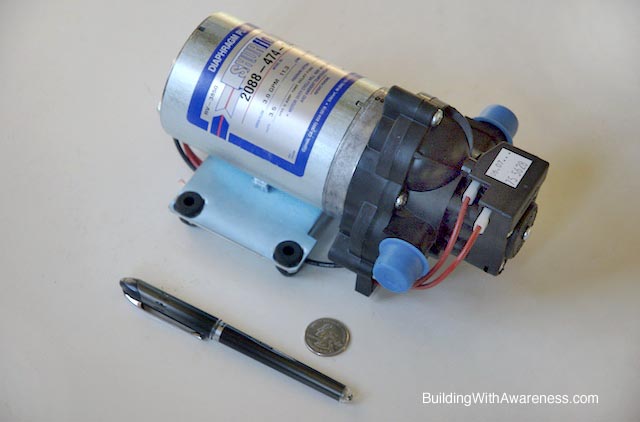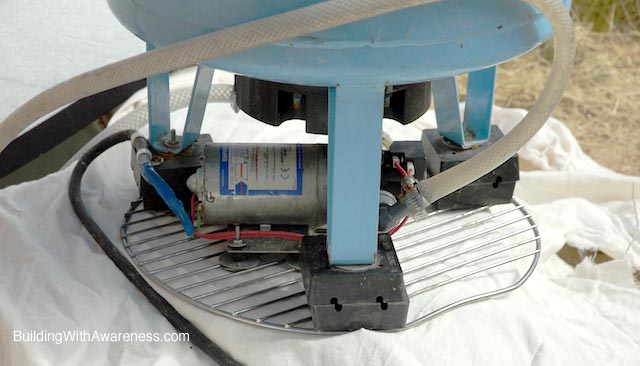
Product Tested: ShurFlo Deluxe 24 volt DC model 2088-474-144 on-demand diaphragm pump, 3 gallons per minute output, with built-in 45psi pressure demand switch. Suggested retail price: $172.00
Ideally, a water pump for a rainwater cistern will use very little electricity, be durable and rugged, and be as maintenance free as possible. The model being reviewed was in daily use for 8 years in a small straw bale house. Water from the cistern delivers naturally soft water to the washing machine, the toilet, and a hose bib. A 24 volt model was chosen so that it could run directly off a 24 volt photovoltaic (PV) electrical system for this off-the-grid green home. Although the PV system included a 120 volt AC inverter, it was desired to have the pump run off the DC side as this would guarantee that the pump would have power even if the inverter was not operational. The DC pump would also be more energy efficient as some efficiency is lost by the inverter. This same pump model is also available in 24 volt and 120 volt configurations.
The advantage of a rubber diaphragm pump is that they are very immune to damage from grit and debris in the water. This is important as water is collected off the roof with only a simple sand filter. In addition, if the cistern should run dry, this type of pump would not be damaged. This ShurFlo pump model is inexpensive (the street price is around $100.00) and it uses little energy (2.4—2.7 amps). It is perfect for running a single fixture at a time. Multiple fixtures will work, although at a much lower flow rate. It is self priming up to 12 feet (less 1 foot per every 1,000 feet of altitude). This means that it will draw water 12 feet below the pump level. Make sure that you do not exceed the maximum distance when the cistern is low on water.

Installation
The pump was installed below ground at a height of half the depth of the tank. In other words, the pump is about level with the water level in the cistern when it is half full. This permitted sufficient water flow at the 5,000 foot altitude of the home’s location. The pump is mounted below a small pressure tank (as seen above) so that the pump does not always turn on when water is needed. The pressure tank acts a buffer and stores water under pressure. The installation details can be seen in the Building With Awareness guidebook.
Maintenance and Performance
This model as worked extremely well for many years. Most problems were not the fault of the pump itself and were almost always due to a small air leak on the suction side of the water line that runs to the rainwater cistern. Suction pumps are very intolerant of the smallest leak as this permits air to enter into the line and thus prevents the pump from drawing water. Always check water line connections when the pump fails to draw properly. Air leaks can usually be traced to a loose hose clamp at a splice or fitting.
During the first eight years of operation (the cistern was also used during the construciton of the house), the rubber diaphragm was replaced once, in addition to the built-in pressure switch. The pressure switch corroded due to moisture, which prevented the pump from turning off when the proper water pressure was reached. The rubber diaphragm started to leak due to age. Both parts are readily available online and were fairly easy to replace after extracting the pump from the plumbing. Most of the repair time was taken by hooking everything up again. The total cost of the replacment parts was approximately $45.00. Some maintenance is to be expected in anything that has moving parts. After eight years of use, the electric motor for the cistern pump no longer had sufficient power to operate properly. The entire pump was then replaced with a new unit of the same model. The new pump has worked flawlessly for the past year.
Other Notes
Years ago I read a report that this type of pump was noisy. The tested model was mounted twenty feet outside the house and two feet below ground. When it is running, there is low hum from the diaphragm vibration that is transmitted through the pipes and to the water fixture. I am very aware of noise pollution and I would not consider this hum a problem. It actually has a positive benefit. On one ocassion the toilet fill valve failed to turn off and it was the hum of the pump that let me know that something was wrong as the pump did not turn off after a couple of minutes. If the pump is to be installed within the home, the room should be insulated for sound.
Conclusion
This ShurFlo pump model worked very well, was cost effective, and would be highly recommended for any green home with a rainwater cistern. It is likely that other voltages in the 1088 model range would have similiar results due to shared components.
article and photos by Ted Owens
I am planning on using a Shurflo 12volt DC, 1 GPM pump, model #8000-541-236, for pumping laundry greywater (filtered) from a 55 gallon drum to 1 toilet tank. The installation would be in the laundry room with pump outlet piping running only about 12 feet to the separated/dedicated toilet tank line. Do you think this will be sufficient? Or do I need a bigger GPM pump? Thanks!!
Hi Jeff,
I believe that a 1 GPM pump will work fine as it sounds like speed is not important. Assuming you are using a 1.5 gallon-per-flush toilet, it will take about a minute and a half to refill the tank. Let us know how your system works out as using graywater for flushing a toilet is a great way to recycle water.
The Shurflo 8000-541-236 provides 1 gpm at open flow but at operating pressure you will only get about .62 gpm
Jeff…just wondering if you tried that Shurflo 8000-541-236 and did it work the way you needed it to?
Wow what a clever contraption, and it has quite a bit of power. This is one way of conserving water and rather using natural elements in a home.
I’m truly glad I discovered this post. I’ve been searching for details on solar energy for awhile.Looking forward to reading more posts about energy.
That sure is a great pump!
The Building With Awareness guidebook is great. Makes installation easy.
Living in Italy we are always running out of water I have installed 200 litre
tank high in roof space ( it takes 12 hours for local authority to refill our small community water supply)… I turn of the town supply to stop back flow and turn on my little system it fills toilet and gives dribble from taps but I think the hot water system (electric) is too high to gravity feed… is there a 220 volt pump available ? pressure sensitive that would work ???
Cheers Lewis
It’s really a great and useful piece of info. I am
satisfied that you simply shared this useful info with us.
Please stay us informed like this. Thank you for
sharing.